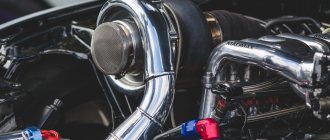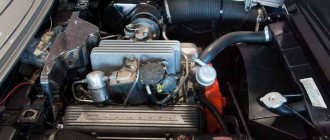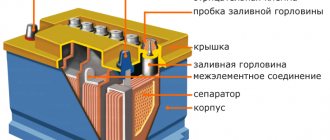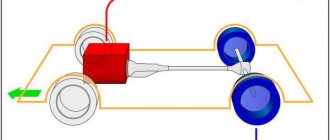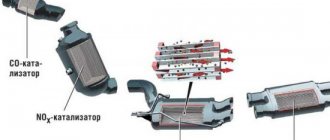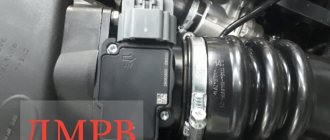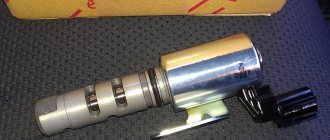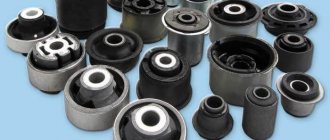- home
- car transmission
- …
Due to many requests from my readers, I am starting to talk about robotic gearboxes. But this is the first article, it will be related to the double clutch, this is an “understanding” for subsequent articles, so that you can already imagine how a robot works with this system. And for general development, this is very useful information, so be sure to read and watch, at the end, as usual, there will be a video version...
Well, first of all, this is the information, many people ask me: “Sergey, please tell me, is it possible to install a double clutch on a manual gearbox? In particular, to our VAZ?”
I’ll answer right away: “Guys, maybe this is something that can somehow be tricked into our VAZES, but I haven’t seen such regular factory transmissions yet! Of course, there are videos on the Internet, like folk craftsmen doing shamanism, but normally for ordinary cars - I PERSONALLY HAVEN’T MEET IT! I haven’t seen it on foreign cars either! Therefore, 90% of the double clutch is installed on “robots” (robotic gearboxes). I’m leaving 10% for “suddenly”, maybe tomorrow our AVTOVAZ will start production!”
Okay, this question is closed, now let's get to the point, I offer some historical information.
History of appearance
The designer Adolf Kegress is rightfully considered the creator; it was he who first outlined the principle of double clutch in 1939. Later, its development in individual versions began to be used on racing tracks, on individual cars. But in widespread use, everything remained on paper. And only in 1980, Porsche took up these developments again.
It was this manufacturer who showed that it was possible to change gears under load, that is, the engine speed was practically not dropped. This development was truly revolutionary because it made it possible to reduce the effect of turbo lag , which is a huge problem for turbocharged engines. Now the switching occurred without jerks or dips, and therefore the torque was transmitted without loss.
4WHEELS
Hi all! Today we will raise the issue of double clutch, we will try to reveal the topic as much as possible and answer the main questions that interest you. You will learn what a double clutch is, who invented it and why, as well as what the pros and cons of a double clutch exist.
Quite a lot of innovations in modern cars, which have already become the norm, migrated from motor sports. The dual clutch system is no exception. For racing cars, every second counts, so every nuance and even gear shift speed are taken into account.
In addition to the obvious advantages and disadvantages of the double clutch, it also has its disadvantages, but before moving on to listing both, I propose to briefly understand how the double clutch works.
Double clutch gearbox
Many people mistakenly believe that a double-clutch transmission is the same “mechanics” only with a “servo drive”. But this is not at all true - however, I can understand some “experts”; they judge by an ordinary robot, that is, which is equipped with an ordinary clutch, if you like - a single one.
Double clutch - makes changes not only to the design of the gearbox itself, but also to the design of the clutch disc (and here there are two of them).
If you take the gearbox itself and correlate it with the mechanics, it turns out that the manual transmission has one drive shaft and all the main gears are located on it. There is also one clutch disc + “basket”. This is a classic arrangement, but the dual clutch has a completely different design.
So: A complex, compound shaft is used here. If you like, this is a “shaft within a shaft.” Roughly, you can imagine it this way: a metal rod (which extends beyond the tube) is inserted into a metal tube and it rotates there. That is, both the tube and the shaft can rotate. This entire structure is this component element.
On one part of the shaft (let’s call it a “tube”), odd-numbered gears are installed, that is, these are the first – third – fifth gears. On the second part of the shaft (let it be a “rod”) there are even second – fourth – sixth gears.
If you want, a dual-clutch transmission combines the work of two manual gearboxes.
What happens in the final balance, everything is simple - these two “mechanical combined transmissions” work alternately, while one accelerates the car, the second is also involved, it already has gearing with the subsequent transmission.
That is, both first and second gears are switched on simultaneously when the car starts. Then the box switches to the second, and again immediately, the third is activated and so on. That is, the transmissions take place alternately.
There is also a part of the robotic system here, these are servo or electric drives, which precisely monitor switching and other actions (clutch discs, for example). There is no torque converter or belt here, as we say in an “ automatic or variator ”, yet the similarity is very great with mechanics.
Malfunctions and problems are typical for DSG
Despite the date of development of the first registered patent (which will soon exceed 90 years), the system is still imperfect and produces problems in some operating modes.
Since DSG is most often installed on the latest “charged” models of cars like Volkswagen, Audi, Porsche, etc., the owners of such cars do not disdain driving in “high-speed” mode. It is with this type of driving that shocks occur when changing gears. This occurs due to the rapid closure of the discs. The main reason for this phenomenon is called the dry type of work. This type causes rapid wear of parts, and as a result the appearance of jerks, squeaks, clanging and grinding noises. The incorrect operation of the electronic unit, which is responsible for the clutch, is to blame for everything.
Operating principle of double clutch
The clutch is the key distinguishing point of the entire transmission. It is worth talking about it separately and in detail.
As we already understood, we have two shafts, and for each of them there is its own clutch “package,” but combined into one housing. THAT is, there are two disks at once! One is located in odd gears 1 – 3 – 5 (or in our example it is a “tube”). The second is for even 2 – 4 – 6 gears (that is, it is a “rod”).
How the work happens - when the car starts, one clutch disc, designed for first gear, is compressed, the second gear is also engaged, but it is not engaged yet, because its disc is open. After the engine speed has reached the desired point (switching), the first disk opens and the second compresses. And since the gear (second gear) is already in mesh, switching occurs instantly, without any shocks or losses.
Switching occurs literally in a fraction of seconds, imperceptible to the driver, the engine and the car as a whole. The average value is from 0.05 to 0.12 seconds.
The discs compress and open alternately, turning on or off one or another gear.
Now there are two options for the clutch of a robotic gearbox: dry and wet.
Mechanism design
To become more familiar with the presented unit, it is necessary to study the structure of the mechanism itself, which ensures smooth gear shifting.
Unlike all other types of clutch, this type is distinguished by the presence of a number of unique components and elements.
So, this system includes the following key components:
- friction disc package;
- housing with dry or oil sump;
- mechatronics
If the first two nodes are quite familiar to car enthusiasts, then the third gives the impression of something hitherto unknown.
So, mechatronics is a high-tech clutch unit that allows you to convert electrical signals into the mechanical operation of actuator units.
The mechatronics of a modern car, as a rule, includes two components: an electromagnetic unit and a control board.
The first is a set of solenoid valves, so-called solenoids. Previously, instead of solenoids, hydraulic distribution mechanisms, the so-called valve blocks, were used. But due to their low performance, they were replaced by more advanced electromagnetic devices.
Let's look at the fundamental features of wet and dry clutches.
"Wet" double
If we take an excursion into the history of the node in question, then the so-called “wet type” is considered to be the progenitor of the double node.
It is a set of two sections of ferodo discs immersed in an oil bath in the clutch housing.
In this case, it is customary to distinguish between two types of “wet clutch” depending on the type of vehicle drive. So, for front-wheel drive cars, a clutch with a concentric arrangement of ferodo discs is used. For owners of rear-wheel drive cars, the peculiarity of this device is manifested in the parallel arrangement of the driven disks.
The components of both types of “wet clutch” are the same. These include:
- inlet flange;
- main flange;
- drive disk;
- package of first and second order friction discs;
- diaphragm spring, auxiliary spring;
- plunger;
- hydraulic cylinders;
- input shaft of the first and second order.
Dry and wet clutch
This is also an important point to note, some are clutch variants, others are “dry”. AT this time, “dry” is the most common; it is installed on almost 70% of cars equipped with such a transmission. “Wet” is used less often, but it works longer.
There are also manufacturers who combine two transmission options on their models, such as Volkswagen. It has DSG 6, which is a wet version, and DSG 7, which is a dry version.
The differences here are critical:
The dry version is almost a complete analogue of a mechanical clutch, that is, the discs rotate in the air and they are physically similar to manual transmission discs. They are compressed or expanded using electric drives.
Wet version - here the discs rotate in a “wet” or oil environment. And they are compressed and decompressed by hydraulics, very similar to the hydraulics on conventional automatic transmissions.
You probably want to - why is the wet version so much more reliable than, say, the dry one? YES, everything is simple - the discs that rotate in oil are cooled in it, so they can withstand high speeds and will not “burn out”. The dry version rotates in the air, and it is limited by speed, because if it is too high, it will literally burn out and collapse.
Conquering the world
In 2008, the BMW M3 and Ford Focus entered the market with gearboxes manufactured by Getrag, and the Nissan GT-R with a six-speed transmission from BorgWarner. A new type of transmission has begun to conquer the world.
Now TDS is actively used by almost all European car manufacturers. The leader here remains the Volkswagen group, which uses such transmissions on models of all its brands, from Škoda and SEAT to Bugatti. At the same time, although Volkswagen produces many transmissions on its own, it uses components from specialized companies - for example, wet clutches from BorgWarner and dry clutches from LuK. And the box for the Bugatti Veyron was produced by the English Ricardo. Transmissions for Ford and Renault are produced by Getrag, and clutches for them are supplied by LuK. Fiat has created its own enterprise for the production of TDS, for which it uses components from both the Italian Magneti Marelli and the American BorgWarner. Volvo produces the TDS at its own plant, although the design is also developed by Getrag, as is the case for Ford and Renault. Genrag also supplies its technologies and boxes to Hyundai, Kia, and Mitsubishi. But Honda itself has developed its own design for Honda and Acura models.
Pros and cons of dual clutch
As usual, no system is perfect, that's how it is here! Although now more and more manufacturers are switching to such robotic transmissions.
Positive points:
- Whatever one may say, this gearbox is currently the most advanced. There are absolutely no jerks or jolts in it, which means the smoothness of the ride is excellent
- Fast gear changes, 0.05 to 0.12 seconds
- Maintaining torque, for turbocharged engines this is critical
- Fuel economy compared to competitors. Even mechanics consume more
- Excellent acceleration dynamics. Again outperforms the competition
But there are also a lot of negative aspects now, and they are very significant
- A very complex mechanism, both the double clutch and the entire transmission as a whole
- A small resource. As a rule, repairs will be required at 60 – 90,000 km
- Expensive, VERY expensive repairs
- There are few services that provide QUALITY repairs
- Jerks and jerks in intensive driving mode, that is, acceleration and stopping, and so on several times, and quickly! In “racing” mode, I would say. When downshifting, it can shift gears more slowly, about 0.4 - 0.6 milliseconds.
In general, guys, there is now a lot of hype about such transmissions, especially about DSG, people are afraid to buy them because of their low service life. Even all the advantages that exist - economy, fuel, dynamics, and smooth movement - fade away after you find out the cost of repairs! Now it is often about 10 - 20% of the cost of the car as a whole. VERY EXPENSIVE! And what’s most offensive is, let’s say if your automatic transmission starts to kick , then you can still drive it. But with a double clutch it’s unlikely, because it dies all at once.
But manufacturers do not lose hope, the quality of materials and technical components are increasing every year, and Volkswagen assures that it has “almost” overcome the problem of wear of parts, the service life has been increased. In addition to this, they install such transmissions in their cars - Audi, BMW, Chrysler, Ford, Volvo.
Now let's watch the video version of the article.
I’ll finish this, I think it was useful. Read our AUTOBLOG.
Similar news
- How to warm up an automatic transmission in cold weather. Is it necessary to do this and chip...
- ROBOT (AMT) or CVT (CVT). Which is better and more reliable? Details +…
- Dual mass flywheel. What is it, how does it work? Breakdowns and r...
Add a comment Cancel reply
The man who introduced DSG
In the second half of the 1990s, Ferdinand Piech, who managed to rise to the top manager of the VW concern, began to intensively promote a dual-clutch design under the brand name DSG (Direkt Schalt Getriebe in German or Direct-Shift Gearbox in English) for “civilian” models . The well-known American company BorgWarner was engaged in the new transmission, and work in this direction went on for eight years. And at the end of 2002, it was announced that mass production of a six-speed gearbox with two clutches would begin on the Volkswagen Golf R32 of the 2003 model year. So 15 years ago TDS entered the world, as they say. As often happens, the name of the pioneer - DSG - is often used as a common noun for all analogues, although this is the proprietary designation of the TDS of the Volkswagen group.
The first DSG - DQ250 (code in the spare parts catalog 02E) began to be installed on a sports modification of the VW Golf, which was called R32. The car was equipped with a 3.2-liter engine that developed 241 hp. For the most powerful and fastest version of the Golf, two advantages of the TDS were especially important: being, in fact, a mechanical transmission, in terms of efficiency it outperforms a hydromechanical “automatic”; in terms of maximum torque and range of gear ratios, it outperforms a variator, and compared to manual control “robot” – the driver has the speed of changing gears (in some cases, shifting takes only a few hundredths of a second). The stage change occurs with virtually no interruption in the power flow.
To implement a dual-clutch design, the DSG has a double drive shaft. The first clutch transmits torque to its outer part, associated with even-numbered gears, and the second – to the inner part, on which odd-numbered gears sit. While one gear is engaged, the automatic system prepares the next one, focusing on the throttle position, speed, acceleration of the car and engine speed - fortunately, in a modern car, information about this flows into the computer. The gear changes occur either automatically or at the driver’s command - using the manual mode selector or steering wheel paddles. On the first DSG, the clutches operate in an oil bath and are controlled by pressure from a hydraulic pump. Wet clutches hold high loads well and resist wear, and circulating oil effectively removes heat from friction pairs. True, the complex valve body made the cost of the DSG commensurate with the cost of a hydromechanical “automatic”, and the pump took away several horsepower. This was acceptable for powerful and expensive cars, but more budget ones had to choose a different design option.
Dry clutches
In 2008, the next version of the DSG appeared - the seven-speed DQ200 (0AM) with two dry clutches, which is designed for torque up to 250 Nm. Internal losses here are noticeably smaller, and electromechanics were connected to help simplified hydraulics. The “dry” version worked more economically, but was noisier and less smooth than the “wet” one, sometimes even with jolts and delays, which usually manifested itself in city traffic. It is also known that malfunctions with the mechatronics that control dry clutches were reported more often. After several upgrades the situation improved.
Over the next two years, two more DSG variants were created, favoring wet clutches. This is the S-Tronic for Audi with a permissible torque of 600 Nm and the DSG version for the transverse power unit, which can handle torque up to 500 Nm.
Somewhat later, in 2012, Porsche remembered its sports experience and, together with ZF, brought its PDK to serial use on the 911 Carrera and Carrera S models. It is seven-speed, with wet clutches and reinforced synchronizers.
Bottom line
The dual clutch is a really good option for those who want a quick shifting gearbox. If you still haven’t been able to decide whether you need to buy a car with a dual clutch, decide whether you are willing to pay the high installation costs and possible risks. Is comfort and regularity while driving very important to you? Does the fact of significant fuel savings appeal to you? If you answer these questions positively, you can rest assured that a dual-clutch car will be your best choice.
Add ProCrossovers to your favorites


